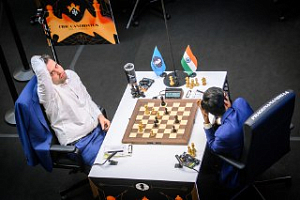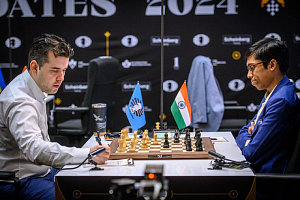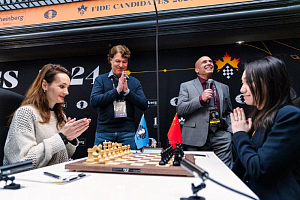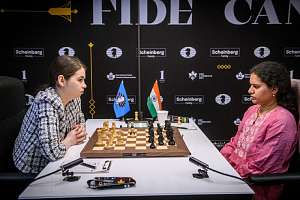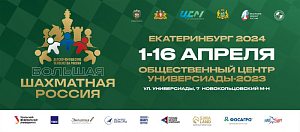12 June 2016
A Masterclass by the Chinese
Close-out review of Vladimir Barsky from the 2016 Belaya Ladya final.
The final of Belaya Ladya in Dagomys has come to an end. Dating back to 1969, the tournament is the nation's oldest competition for schoolchildren, which has never been interrupted even once since then. Foreign teams have started joining Belaya Ladya in the year 2015. Besides 82 teams from different regions of Russia, the 2016 final has now got 9 teams from such foreign countries as Armenia, Belarus, Israel, Kyrgyzstan, China, Latvia, Moldova, Mongolia and Estonia. All in all, over 6.5 thousand schoolchildren under14 years of age from all regions of Russia took part in the regional qualification tournaments during the school year 2015-2016.
The tournament organizers are the Russian Chess Federation and the Ministry of Sports of the Russian Federation. Competitions are organized with support from the Ministry of Education and Science of the Russian Federation and the Elena and Gennady Timchenko Charitable Foundation.
Having scored 29.5 out of 36 points, the Chinese schoolchildren won the 2016 final more than convincingly with one round to go. The second place with 24 points was taken by the pupils of the 2nd Gymnasium of St. Petersburg -- they landed ahead of the Armenian children in terms of better additional tiebreakers. Thus, the pupils of the 2nd Gymnasium of St. Petersburg have become the best Russian team for the second consecutive year and will thus represent Russia in the "Friendship Match". This match is planned to take place in Petropavlovsk-Kamchatsky.
For the second time in the history of the tournament the children from orphanages have been participating in the final of "Belaya Ladya". This time this is Specialized Boarding School #1 of Simferopol, which won the Ascension tournament among orphanage and boarding schools, which took place this year in May at the premises of the Sochi hotel Zhemchuzhina, being the first competitive event among teams of Orphanages and Boarding Schools. Participation of this team became possible owing to the RCF program aimed at providing chess education to parentless children. Within the 2014-2016 period over 300 institutions (orphanages and boarding schools) from 60 regions of Russia have joined the program, with chess clubs in place and functioning and experienced teachers and trainers working in them already. RCF plans to continue delivery of chess equipment and to carry out town-, district- and nation-wide competitions among Orphanages and Boarding Schools educatees as part of further program development.
As tradition has it, a broad cultural program bore company to the over the board battles. Andrey Shumakov, the World Champion in Brain Ring, carried out trivia contests "What, Where, When?", "Assorti", "Brain Ring." Young players visited master classes held by head coach of the women's national team Sergei Rublevsky as well as lectures given by the merited coach of the USSR Mark Dvoretsky. Besides, schoolchildren were able to challenge each other in the active type of sports -- table tennis, volleyball and football.
Now we would like to offer you the game, which S. Rublevsky rated as the tournament's best.
Sidorov – Sirodzhov
Caro-Kann Defence
Comments by Anton Sidorov
1.e4 c6 2.Nc3 d5 3.Qe2 d4 4.Nd1
The idea of this line is that White intends to develop with d3, g3, and the f4, followed by fianchetoeing his bishop on g2 and playing Nf3, obtaining a type of position much similar to the King's Indian defense, only with the colors reversed.
4...Qc7 5.g3 e5 6.Bg2 Nf6 7.d3 Bd6
Black does his best to stifle the f4 advance.
8.f4 0–0
Better is 8...exf4 9.Nf3 (9.e5? Qa5+ 10.Bd2 Qxe5 11.Bxf4 Qxe2+ 12.Nxe2 Bxf4 13.Nxf4 0–0, and Black is up a healthy pawn) 9...0–0 10.gxf4 Bxf4 11.Bxf4 Qxf4 12.Nxd4 with equality.
9.f5
White closes the position, obtaining space advantage on the kingside where he plans to launch his offensive.

9...b6
This is not a good plan. Better was 9...с5, followed by Nс6, Bd7, b5 and c4, creating counterplay on the queenside. For example: 9...c5 10.Nf3 Nc6 11.0–0 Bd7 12.Nf2 b5 13.g4 h6 14.h4 Be7 15.Bd2 Rfc8, intending to break the position open with с4.
10.Nf3 Rd8 11.0–0 Nbd7 12.Nf2 Ba6
Black's play is too slow.
13.g4
White starts his offensive.
13...Ne8
If 13...h6!?, then 14.h4 c5 15.b3 Bb7 16.g5 hxg5 17.hxg5 Nh5 18.Re1 b5 19.Ng4 c4 20.Kf2 with a small edge for White.
14.g5 f6 15.h4 Nf8
Black goes into a deep defensive stance.
16.Bh3 c5 17.b3
White stops the immediate c4 advance.
17...Qf7 18.Kh1
White is regrouping his forces.
18...Rac8 19.Rg1 Kh8 20.a4
White stops the b5 advance.
20...Rc7 21.Bd2 Bc8 22.Rg2 g6?
Black weakens his position voluntarily.

23.gxf6
Even stronger is 23.Ng4! Nd7 24.gxf6 Nexf6 25.fxg6 hxg6 26.Ng5 Qe7 27.Nh6, and Black's setup collapses.
23...Nxf6 24.Rag1
White has brought all his pieces into the action, building up a powerful battery along the g-file.
24...Re8 25.Bh6
25.Ng4! was a good move, intending to exchange one of Black's defending pieces, the f6-knight.
25...Nh5 26.Ng5 Qf6 27.Ng4 Qd8?
Although 27...Qe7 is a more stubborn continuation, after the following exemplary continuation 28.Nf3 a6 29.Ngxe5 Bxe5 30.Nxe5 Qxh4 (or 30...Qxe5 31.Qxh5+–) 31.Qg4 Qxg4 32.Bxg4 Rxe5 33.Bxh5 White would be winning anyway.

28.Nxe5!! Bxe5 29.Qxh5!! Be6
29...gxh5 30.Nf7+! Rxf7 31.Rg8# fails likewise.
30.fxe6 Nxe6 31.Nxe6 Black resigns.
Below-given is yet another vivid fragment to wrap up our review.
Kirillov – Asatrian

21.Nxf7! Kxf7 22.Bb3 Rxd4 23.Qe3 Re4 24.fxe4 Qa5 25.Qf2 Qc5 26.Rd7+ Black resigns.














